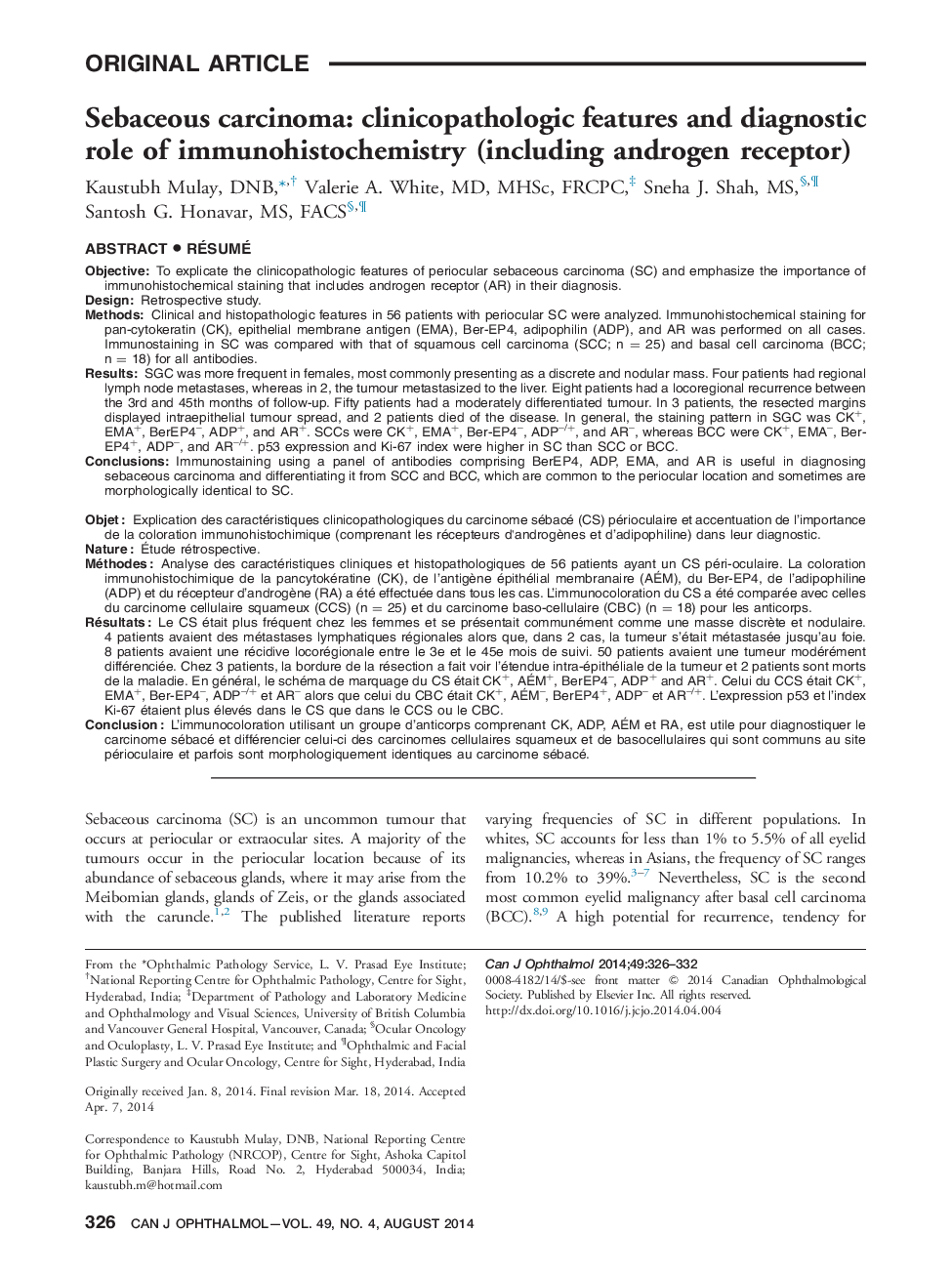| Article ID | Journal | Published Year | Pages | File Type |
|---|---|---|---|---|
| 4009316 | Canadian Journal of Ophthalmology / Journal Canadien d'Ophtalmologie | 2014 | 7 Pages |
ObjectiveTo explicate the clinicopathologic features of periocular sebaceous carcinoma (SC) and emphasize the importance of immunohistochemical staining that includes androgen receptor (AR) in their diagnosis.DesignRetrospective study.MethodsClinical and histopathologic features in 56 patients with periocular SC were analyzed. Immunohistochemical staining for pan-cytokeratin (CK), epithelial membrane antigen (EMA), Ber-EP4, adipophilin (ADP), and AR was performed on all cases. Immunostaining in SC was compared with that of squamous cell carcinoma (SCC; n = 25) and basal cell carcinoma (BCC; n = 18) for all antibodies.ResultsSGC was more frequent in females, most commonly presenting as a discrete and nodular mass. Four patients had regional lymph node metastases, whereas in 2, the tumour metastasized to the liver. Eight patients had a locoregional recurrence between the 3rd and 45th months of follow-up. Fifty patients had a moderately differentiated tumour. In 3 patients, the resected margins displayed intraepithelial tumour spread, and 2 patients died of the disease. In general, the staining pattern in SGC was CK+, EMA+, BerEP4–, ADP+, and AR+. SCCs were CK+, EMA+, Ber-EP4–, ADP–/+, and AR–, whereas BCC were CK+, EMA–, Ber-EP4+, ADP–, and AR–/+. p53 expression and Ki-67 index were higher in SC than SCC or BCC.ConclusionsImmunostaining using a panel of antibodies comprising BerEP4, ADP, EMA, and AR is useful in diagnosing sebaceous carcinoma and differentiating it from SCC and BCC, which are common to the periocular location and sometimes are morphologically identical to SC.
RésuméObjetExplication des caractéristiques clinicopathologiques du carcinome sébacé (CS) périoculaire et accentuation de l’importance de la coloration immunohistochimique (comprenant les récepteurs d'androgènes et d’adipophiline) dans leur diagnostic.NatureÉtude rétrospective.MéthodesAnalyse des caractéristiques cliniques et histopathologiques de 56 patients ayant un CS péri-oculaire. La coloration immunohistochimique de la pancytokératine (CK), de l’antigène épithélial membranaire (AÉM), du Ber-EP4, de l’adipophiline (ADP) et du récepteur d’androgène (RA) a été effectuée dans tous les cas. L’immunocoloration du CS a été comparée avec celles du carcinome cellulaire squameux (CCS) (n = 25) et du carcinome baso-cellulaire (CBC) (n = 18) pour les anticorps.RésultatsLe CS était plus fréquent chez les femmes et se présentait communément comme une masse discrète et nodulaire. 4 patients avaient des métastases lymphatiques régionales alors que, dans 2 cas, la tumeur s’était métastasée jusqu’au foie. 8 patients avaient une récidive locorégionale entre le 3e et le 45e mois de suivi. 50 patients avaient une tumeur modérément différenciée. Chez 3 patients, la bordure de la résection a fait voir l’étendue intra-épithéliale de la tumeur et 2 patients sont morts de la maladie. En général, le schéma de marquage du CS était CK+, AÉM+, BerEP4–, ADP+ and AR+. Celui du CCS était CK+, EMA+, Ber-EP4–, ADP–/+ et AR– alors que celui du CBC était CK+, AÉM–, BerEP4+, ADP– et AR–/+. L’expression p53 et l’index Ki-67 étaient plus élevés dans le CS que dans le CCS ou le CBC.ConclusionL’immunocoloration utilisant un groupe d’anticorps comprenant CK, ADP, AÉM et RA, est utile pour diagnostiquer le carcinome sébacé et différencier celui-ci des carcinomes cellulaires squameux et de basocellulaires qui sont communs au site périoculaire et parfois sont morphologiquement identiques au carcinome sébacé.
